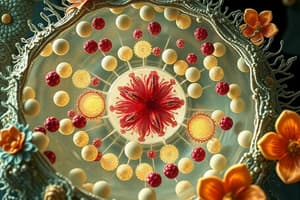Podcast
Questions and Answers
Which organelle is primarily responsible for modifying, sorting, and packaging proteins for secretion or delivery to other organelles?
Which organelle is primarily responsible for modifying, sorting, and packaging proteins for secretion or delivery to other organelles?
- Lysosome
- Ribosome
- Mitochondrion
- Golgi Body (correct)
What is the role of lysosomes in a eukaryotic cell?
What is the role of lysosomes in a eukaryotic cell?
- Energy production
- Digesting macromolecules (correct)
- Protein synthesis
- Photosynthesis
Which of the following structures would be found in a plant cell but not in an animal cell?
Which of the following structures would be found in a plant cell but not in an animal cell?
- Vesicle
- Chloroplast (correct)
- Endoplasmic Reticulum
- Nucleus
What is the main function of the smooth endoplasmic reticulum (ER)?
What is the main function of the smooth endoplasmic reticulum (ER)?
Which component of an animal cell is primarily involved in maintaining cell shape and facilitating movement?
Which component of an animal cell is primarily involved in maintaining cell shape and facilitating movement?
Which scientist is NOT associated with the development of Modern Cell Theory?
Which scientist is NOT associated with the development of Modern Cell Theory?
What is a fundamental characteristic of all living cells according to Modern Cell Theory?
What is a fundamental characteristic of all living cells according to Modern Cell Theory?
Which structure is primarily responsible for regulating transport across the cell membrane?
Which structure is primarily responsible for regulating transport across the cell membrane?
Which of the following organisms is an example of a unicellular organism?
Which of the following organisms is an example of a unicellular organism?
What was one of the first materials through which cells were observed, as described by Robert Hooke?
What was one of the first materials through which cells were observed, as described by Robert Hooke?
Flashcards are hidden until you start studying
Study Notes
Cell Basics
- Basic unit of life; smallest functional unit of all organisms.
- First described by Robert Hooke in 1665 using cork.
- Cell Theory: all living cells arise from pre-existing cells, cells are fundamental to multicellular life, and every living organism consists of one or more cells.
Prokaryotic vs Eukaryotic Cells
- Prokaryotic: simple, single-celled organisms like bacteria, no membrane-bound nucleus, fewer organelles.
- Eukaryotic: complex, multicellular organisms (plants and animals), larger size, membrane-bound nucleus, numerous organelles.
Animal vs Plant Cells
- Animal Cells: contain centrioles, lysosomes, and lack cell walls and chloroplasts; often more flexible in shape.
- Plant Cells: have cell walls, chloroplasts (for photosynthesis), and a large central vacuole.
Cellular Organelles & Functions
- Mitochondria: energy producers through cellular respiration; have own DNA and ribosomes.
- Chloroplasts: sites of photosynthesis; contain chlorophyll and double membranes.
- Ribosomes: protein synthesis; can be free in cytoplasm or attached to ER.
- Endoplasmic Reticulum:
- Rough ER: helps fold and transport proteins, has ribosomes.
- Smooth ER: involved in lipid synthesis, lacks ribosomes.
- Golgi Apparatus: processes, packages, and distributes proteins and lipids.
- Lysosomes: contain enzymes for digestion, act as waste disposal by breaking down macromolecules.
- Nucleus: control center, stores DNA, and synthesizes RNA.
- Vacuoles: large storage structures, typically in plant cells, filled with fluid.
Cell Membrane
- Selectively permeable barrier controlling movement of substances in and out of the cell; integral to transport mechanisms.
Cell Movement
- Cells use locomotory structures like flagella (long hair-like protrusions) and amoeboid projections for movement and feeding.
Shapes and Sizes of Cells
- Cells vary in shape and size based on their function; examples include muscle cells (spindle-shaped), blood cells (circular), nerve cells (extended for communication), and skin cells (flat for protection).
Overall Themes
- Understanding cell structure and function is essential to grasp biological organization from cells to tissues and organ systems.
- The study of cells lays the foundation for comprehending the mechanisms of life and organismal biology.
Studying That Suits You
Use AI to generate personalized quizzes and flashcards to suit your learning preferences.




